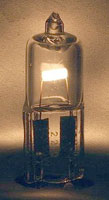What are they?
The halogen light bulb or lamp is a type of incandescent lamp which uses a halogen gas in order to increase both light output and rated life. They are known for moderately high efficiency, quality of light, and high rated life compared to regular incandescent lamps.
Where did they come from?

The early history of the halogen lamp parallels that of the incandescent. The usage of chlorine to prevent blackening of the lamp was patented in 1882. In 1959, General Electric patented a commercially viable halogen lamp using iodine as the halogen gas.
How do they work?
A halogen lamp functions identically to an incandescent lamp, with one notable exception: The halogen cycle.
In a typical incandescent lamp, tungsten slowly evaporates from the burning filament. This causes blackening of the lamp, which decreases light output and reduces life.

Halogen lamps are largely able to eliminate this problem because the halogen gas reacts chemically with the evaporated tungsten to prevent it from affixing to the glass. Some tungsten is returned to the filament, which also serves to increase the rated life of the lamp. Because the temperature required for this reaction is higher than a typical incandescent bulb, halogen lamps must generally be manufactured using quartz.
Where are they used?
Halogen lamps are used in a variety of applications, both commercial and residential. Halogen lamps are used in automotive headlamps, under-cabinet lighting, and work lights. In addition, halogen reflectors like MR and PAR lamps are often preferred for directed lighting such as spotlights and floodlights. They are also increasingly being used as a more efficient alternative to incandescent reflectors. There are not many situations in which halogen lamps cannot be used, but one potential downside is the heat generated by halogen lamps, particularly in areas where HVAC costs are a concern.
Other Helpful Resources